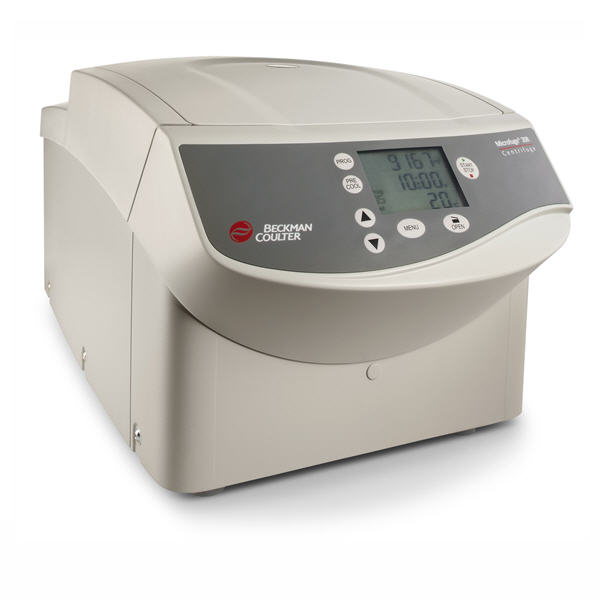Beckman Coulter
- Microfuge 20 Series
- Available in both refrigerated (Microfuge 20R) and non-refrigerated (Microfuge 20) versions
- Four different rotor options from which to choose
- Safely process hazardous samples with an optional BioCertified rotor
- Quickly process samples at maximum speeds of up to 15,000 rpm (20,627 x g)
- Spin more samples per run with a maximum capacity of 36 x 1.5/2.0 mL tubes
- Intuitive user interface displays both speed (rpm) and RCF (xg)
- Decrease setup time with user-defined programs for common protocols
- Lower utility costs with increased energy efficiency

Height, door closed: 29.1 cm (11.5 in.)
Temperature Display: chamber temperature in 1°C increments
Width: 31.0 cm (12.2 in.)
Depth: 66.0 cm (26.0 in.)
Weight: 32 kg (70.5 lb)
Electrical Requirements: 220–240 VAC, 2.4 A, 50 Hz
Maximum Heat Dissipation into Room under Steady-State Conditions: 1433 BTU/h (420 W)
Noise Level 0.91 meters (3 feet) in Front of Centrifuge: < 58 dB
Set Speed: 15,000 rpm (in 100-rpm increments) min: 200 rpm
Set Temperature: –10 to +40°C (in 1°C increments)
Set Time: 99 min, 59 sec in one second increments or continuous (∞)
Speed Control: actual rotor speed, ± 50 rpm of set speed
Temperature Control: ± 2.5°C of set temperature
Ambient Temperature Range: 5 to 35°C
Clearances Required: 30 cm (11.8 in.) (sides)
Humidity Restrictions: <80% (noncondensing)
Pollution Degree: 2
Time -- Actual Display: time remaining in run (timed run ±1 min accuracy) or ∞ and elapsed
Installation Category: II
Speed Display: actual rotor speed in 100-rpm increments or in RCF (when selected)
Temperature Display: chamber temperature in 1°C increments
 | Versatility to meet your application needs | |
 | Increased speed and capacity | |
 | Easy to use and incorporate into your lab |

